A United States Bucket List
By John M. Hotchner
 Not so long ago bucket lists burst on the scene. If your nose was in your albums and you missed it, the idea was put forward that all of us approaching the September of our lives should make a list of those things we wished to do or see before December 31st of our lives.
Not so long ago bucket lists burst on the scene. If your nose was in your albums and you missed it, the idea was put forward that all of us approaching the September of our lives should make a list of those things we wished to do or see before December 31st of our lives.
Well, here I am at about October 25, and as a charter member of the procrastinators’ club, I’m just getting to this task. I’ve recently done such a list with a worldwide perspective, and found it interesting to put a laser-like focus on what I really want to get done. A friend who saw it suggested that I ought to narrow the scope to U.S. philately only, and provide it here as a means of encouraging our U.S. collector community members to do their own lists.
The size of the list is an issue. Some are satisfied with ten items. It is said that too many disappointments are the result of too many expectations, but I’ll chance it. Thus, my list presented here is 20 items; which actually works out to one a year until I’m 93. That seems do-able, if maybe a tad ambitious.
But the point is not so much to get it all done as to help the mind to have a sense of what is really important versus what is passing fancy. This can be useful for resource allocation–what will we spend both time and money on–and for sense of satisfaction as items are crossed off.
Given that no one wants to reach the end of the list and have nothing to live for, so to speak, my method will be to add something to the list every time I cross something off. It is important to have a challenge to get up for every morning!
This is a highly individual exercise. Which is a way of saying that my list won’t work for you. But perhaps it will serve as a guide on the sorts of things that you want to consider for your own list. So, even those of you who are at March 1st of your lives, I hope you will do this exercise. Dream big!
Here is my effort:
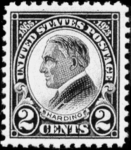 1. Find a U.S. Scott #613, the rotary press-printed 2¢ Black Harding, perf 11. There are about 65 examples known, and I believe there are more waiting to be discovered. Since buying one is out of the question (Cat. Value: $40,000), I measure every 2¢ Harding I come across. Maybe lightening will strike!
1. Find a U.S. Scott #613, the rotary press-printed 2¢ Black Harding, perf 11. There are about 65 examples known, and I believe there are more waiting to be discovered. Since buying one is out of the question (Cat. Value: $40,000), I measure every 2¢ Harding I come across. Maybe lightening will strike!
2. Get up enough courage to start collecting U.S. revenues. I have a set of Scott album pages, but the project looks daunting. Yet much of it is affordable, and interesting, and I want to get started, but just have not been able to nd the time–or make the time.
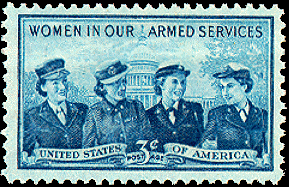 3. Solve the mystery of the 3¢ Servicewomen commemorative of 1952, Scott #1013, which features four servicewomen as portrayed by professional models. I know the name of one. Who are the others? Research in the les of the USPS, Bureau of Engraving and Printing, and Defense Department have failed to bring the names to light. Someone must know.?
3. Solve the mystery of the 3¢ Servicewomen commemorative of 1952, Scott #1013, which features four servicewomen as portrayed by professional models. I know the name of one. Who are the others? Research in the les of the USPS, Bureau of Engraving and Printing, and Defense Department have failed to bring the names to light. Someone must know.?
4. My hoard of Korean War postal history awaits. I bought a first class exhibit several years ago, and have my own material gathered over 30 years to add to it; and continue to find new covers. The task now is to recast and improve the exhibit.
5. My U.S. clipping files have as much unfiled material as what is in the folders. This is a 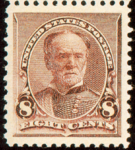 project that needs some serious work.
project that needs some serious work.
6. Get used copies of the USIR-watermarked 8¢ Sherman (Scott #272a) and $1 Prexie (#832b) for my collection.
7. Do or update at least one one-frame exhibit a year: Pending are #C22 international uses, C32 international uses, methods of marking repaired and rejected material in the Bureau of Engraving and Printing, and The Naked Maja in U.S. philately. (Readers may notice a theme here: there is an awful lot of exhibiting going on, but it has become over the years one of my favorite creative outlets, and I can’t get enough of it!)
8. Update my 1934 and 1935 Christmas seal multi-frame exhibits.
9. Encourage those who can make it happen to get a U.S. philatelic periodical on U.S. newsstands. I’m convinced that this could make a real difference in bringing 30-somethings and beyond into the hobby.
10. Give a presentation on U.S. Error, Freak and Oddity Collecting at the Royal Philatelic Society, London.
11. Reread the George Brett book on Giori Printing; the best exposition of a complex subject that marked a turning point (in the mid-1950s) in U.S. stamp production; enabling multicolor printing, and bringing life to what had been almost entirely a monocolor stamp program.
12. Convince Scott Catalogue editors to include the Allied Military Government issues from Austria, France, Germany and Italy in the U.S. Specialized Catalogue; not to mention the Korean issues. Scott includes Ryukyus, but that is only a good start.
13. Organize a 40-year accumulation of Washington-Franklin (3rd Bureau Issue) local precancels, and while I’m at it, try to discover a Scott #544, the 1¢ Rotary Press sheet waste stamp; often seen precancelled.
14. Do a booklet or book on the 60+ instances where living people are shown on U.S. stamps. This has been one focus of my Linn’s reporting over the years, and there are many interesting stories to be told.
15. Find for my mourning covers collection, a cover to or from a funeral home that was sent to a dead letter office (preferably in Deadwood, South Dakota).
16. Make sense, and maybe an exhibit, of a 50-year accumulation of U.S. postal cards with printed messages on the back that show the everyday and often munda ne activities of Americans in the late 19th and early 20th centuries; from birth to death.
ne activities of Americans in the late 19th and early 20th centuries; from birth to death.
17. Judging at the next U.S. international: 2026 in Boston!
18. Write an article on U.S. postal counterfeits each year for the book-length Fakes Forgeries Experts, produced under the auspices of the International Association of Philatelic Experts (AIEP).
19. Spend some time every day, washing, organizing, cataloguing, and putting stamps in my albums. It is surprising how easy it is for that set of activities to take last place.
20. Be around, at age 97, to celebrate and ponder the glorious 200th anniversary of postage stamps in the year 2040, and maybe even the equally glorious 200th anniversary of U.S. postage stamp general issues in 2047. Medical science is making great strides in extending life!
Fulfilling some of the entries in this list will depend upon luck (rather than bucks), medical practitioners, help from friends, will power, and the grace of God. But hopefully in 20 years or so, I can look back and say I’ve crossed at least half off the list. Now, get started on your list!
Should you wish to comment on this column, or have questions or ideas you would like to have explored in a future column, please write to John Hotchner, VSC Contributor, P.O. Box 1125, Falls Church, VA 22041-0125, or email, putting “VSC” in the subject line.
Or comment right here.

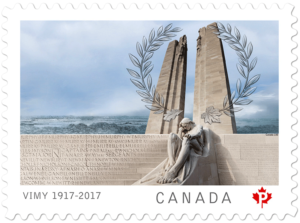 OTTAWA – On April 8, 2017, Canada Post will issue commemorative stamps to mark the 100th anniversary of the Battle of Vimy Ridge, an impressive victory in the First World War that was a coming-of-age moment for Canada.
OTTAWA – On April 8, 2017, Canada Post will issue commemorative stamps to mark the 100th anniversary of the Battle of Vimy Ridge, an impressive victory in the First World War that was a coming-of-age moment for Canada.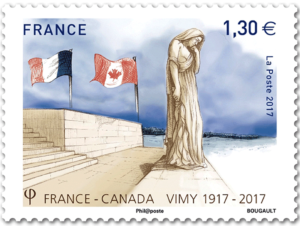 At 5:30 a.m. on April 9, 1917, the first wave of soldiers in the nearly 100,000-strong Canadian Corps emerged from their muddy trenches. The Corps was ordered to seize a heavily fortified and strategic height of land, Vimy Ridge, in northern France. The ridge had been a virtually impregnable German-held position since early in the war and had withstood several previous assaults, at great cost to the Allies.
At 5:30 a.m. on April 9, 1917, the first wave of soldiers in the nearly 100,000-strong Canadian Corps emerged from their muddy trenches. The Corps was ordered to seize a heavily fortified and strategic height of land, Vimy Ridge, in northern France. The ridge had been a virtually impregnable German-held position since early in the war and had withstood several previous assaults, at great cost to the Allies.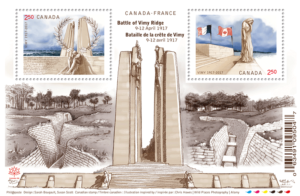 It was one of the most impressive Allied victories of the First World War – but it came at a heavy price. Nearly 3,600 Canadians were killed and more than 7,000 were wounded over four days of bitter fighting. The Canadian soldiers’ bravery, determination and skillful precision at Vimy earned Canada international accolades. To this day, the Battle of Vimy Ridge is considered by many to be one of the defining moments that helped to forge a proud, more independent identity for a nation that was still relatively young.
It was one of the most impressive Allied victories of the First World War – but it came at a heavy price. Nearly 3,600 Canadians were killed and more than 7,000 were wounded over four days of bitter fighting. The Canadian soldiers’ bravery, determination and skillful precision at Vimy earned Canada international accolades. To this day, the Battle of Vimy Ridge is considered by many to be one of the defining moments that helped to forge a proud, more independent identity for a nation that was still relatively young.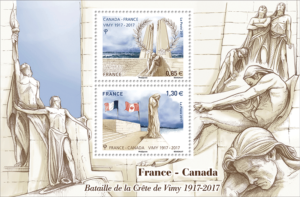 “The Battle of Vimy Ridge saw thousands of Canadians make the ultimate sacrifice and is the best-known chapter in our country’s proud First World War history,” says Deepak Chopra, President and CEO of Canada Post. “The valour of Canadians at Vimy a century ago is a poignant reminder of the enormous price paid so we can live in freedom.”
“The Battle of Vimy Ridge saw thousands of Canadians make the ultimate sacrifice and is the best-known chapter in our country’s proud First World War history,” says Deepak Chopra, President and CEO of Canada Post. “The valour of Canadians at Vimy a century ago is a poignant reminder of the enormous price paid so we can live in freedom.”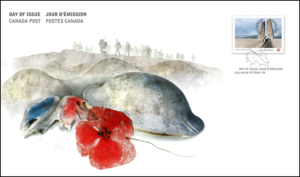 The sheer scale of the monument reflects Canada’s important contribution to Allied victory in the First World War. In the foreground of the stamp is a figure of a grieving man, one of the monument’s statues, symbolizing loss and grief. The ridge behind the monument on the stamp recalls the site of the battle itself.
The sheer scale of the monument reflects Canada’s important contribution to Allied victory in the First World War. In the foreground of the stamp is a figure of a grieving man, one of the monument’s statues, symbolizing loss and grief. The ridge behind the monument on the stamp recalls the site of the battle itself.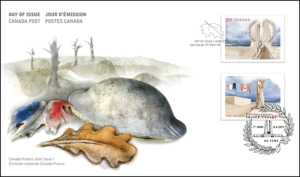 the monument. They are a memorial to all the Canadians who died in France during the First World War and had no known grave at the time. Laurel sprigs surrounding the monument’s two towers on the stamp represent the victory and tragic loss of life. A maple leaf on one sprig represents Canada, while an oak leaf on the other represents France.
the monument. They are a memorial to all the Canadians who died in France during the First World War and had no known grave at the time. Laurel sprigs surrounding the monument’s two towers on the stamp represent the victory and tragic loss of life. A maple leaf on one sprig represents Canada, while an oak leaf on the other represents France.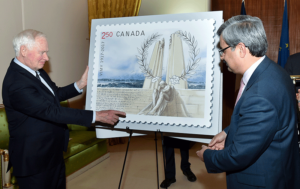 Canada Post and France’s La Poste unveiled stamps to honour the Canadian soldiers who fought in the Battle of Vimy Ridge in 1917. His Excellency the Right Honourable David Johnston, Governor General of Canada (left), was joined by Deepak Chopra, President and CEO of Canada Post, to unveil the Canadian stamp. France’s stamp was unveiled by His Excellency Nicolas Chapuis, Ambassador of France to Canada, and Benoît Georges, representative of La Poste for the Americas. Photo by Denis Drever\Canada Post.
Canada Post and France’s La Poste unveiled stamps to honour the Canadian soldiers who fought in the Battle of Vimy Ridge in 1917. His Excellency the Right Honourable David Johnston, Governor General of Canada (left), was joined by Deepak Chopra, President and CEO of Canada Post, to unveil the Canadian stamp. France’s stamp was unveiled by His Excellency Nicolas Chapuis, Ambassador of France to Canada, and Benoît Georges, representative of La Poste for the Americas. Photo by Denis Drever\Canada Post.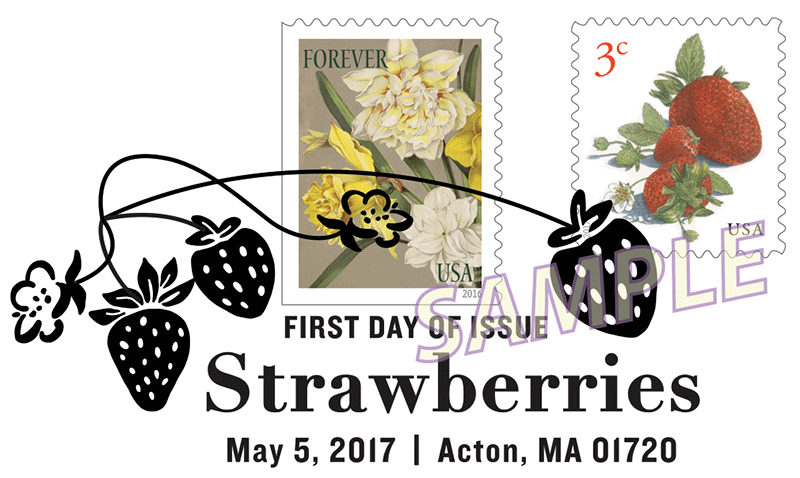 It measures 2.89″ x 1.31″.
It measures 2.89″ x 1.31″.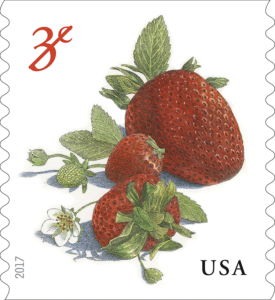 On May 5, 2017, in Acton, MA, the U.S. Postal Service will issue the 3-cent Strawberries stamp, in one design, in a pressure-sensitive adhesive (PSA) coil of 10,000 stamps (Item 760300). The stamp will go on sale nationwide May 5, 2017.
On May 5, 2017, in Acton, MA, the U.S. Postal Service will issue the 3-cent Strawberries stamp, in one design, in a pressure-sensitive adhesive (PSA) coil of 10,000 stamps (Item 760300). The stamp will go on sale nationwide May 5, 2017. Item Number: 564500
Item Number: 564500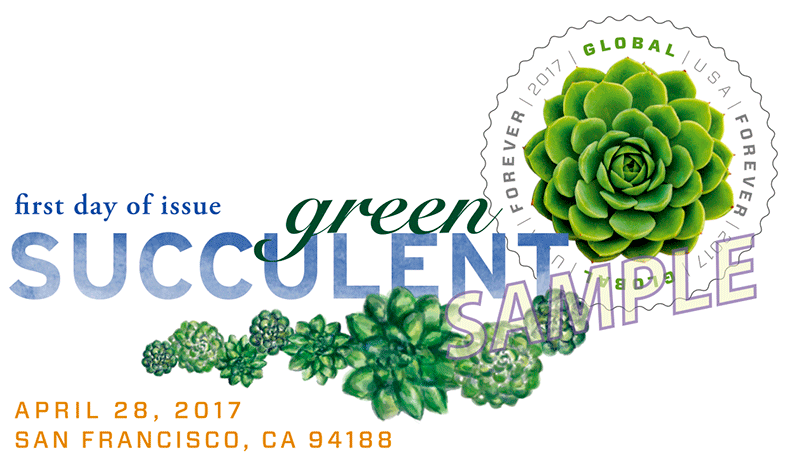 It measures 2.97” x 1.23″.
It measures 2.97” x 1.23″.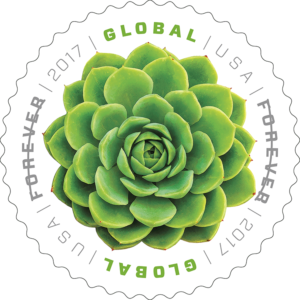 On April 28, 2017, in San Francisco, CA, the U.S. Postal Service will issue the Green Succulent Global Forever International rate stamp, in one design, in a pressure-sensitive adhesive (PSA) pane of 10 stamps (Item 564500). The stamp will go on sale nationwide April 28, 2017.
On April 28, 2017, in San Francisco, CA, the U.S. Postal Service will issue the Green Succulent Global Forever International rate stamp, in one design, in a pressure-sensitive adhesive (PSA) pane of 10 stamps (Item 564500). The stamp will go on sale nationwide April 28, 2017.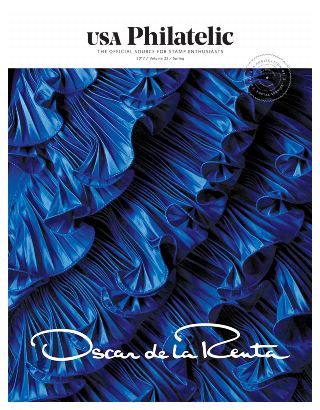 We are excited to announce the redesign of USA Philatelic, a robust vehicle that provides knowledge and personal insight into the creativity of stamps to inspire stamp collecting. Readers will now have access to exclusive background information about stamps, learn new ways to create beautiful mail, and explore new philatelic products in the Product Spotlight section.
We are excited to announce the redesign of USA Philatelic, a robust vehicle that provides knowledge and personal insight into the creativity of stamps to inspire stamp collecting. Readers will now have access to exclusive background information about stamps, learn new ways to create beautiful mail, and explore new philatelic products in the Product Spotlight section.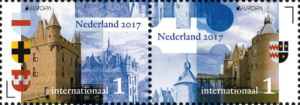 The Hague – PostEurop’s annual European design competition puts castles in the spotlight this year. PostNL is therefore issued on February 20 the stamp sheetlet ‘Dutch Castles’ featuring the medieval moated castles Doornenburg and Ammersoyen in Gelderland.
The Hague – PostEurop’s annual European design competition puts castles in the spotlight this year. PostNL is therefore issued on February 20 the stamp sheetlet ‘Dutch Castles’ featuring the medieval moated castles Doornenburg and Ammersoyen in Gelderland.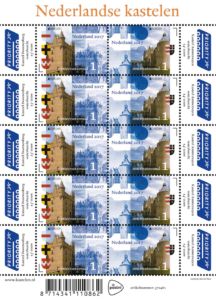 stamp sheetlet as examples of recognisable fortified dwellings of the Middle Ages. The contrast between the castles is shown by overlapping photos including a historical letter and the outline of the floor plan. Both castles have broad moats for defence against hostile attacks. Additionally, Doornenburg Castle is familiar to many Dutch people as the setting for the popular 1960s Dutch TV series “Floris”.
stamp sheetlet as examples of recognisable fortified dwellings of the Middle Ages. The contrast between the castles is shown by overlapping photos including a historical letter and the outline of the floor plan. Both castles have broad moats for defence against hostile attacks. Additionally, Doornenburg Castle is familiar to many Dutch people as the setting for the popular 1960s Dutch TV series “Floris”. From now on, PostNL will deliver food products seven days a week via the special food network. More and more people are buying their food products online, both in cities and in rural areas. PostNL delivers shopping, meal boxes and specialty products such as meat and sports nutrition for various providers. Since February 2017, PostNL has also been delivering Marley Spoon and De Krat meal boxes.
From now on, PostNL will deliver food products seven days a week via the special food network. More and more people are buying their food products online, both in cities and in rural areas. PostNL delivers shopping, meal boxes and specialty products such as meat and sports nutrition for various providers. Since February 2017, PostNL has also been delivering Marley Spoon and De Krat meal boxes. Not so long ago bucket lists burst on the scene. If your nose was in your albums and you missed it, the idea was put forward that all of us approaching the September of our lives should make a list of those things we wished to do or see before December 31st of our lives.
Not so long ago bucket lists burst on the scene. If your nose was in your albums and you missed it, the idea was put forward that all of us approaching the September of our lives should make a list of those things we wished to do or see before December 31st of our lives. 1. Find a U.S. Scott #613, the rotary press-printed 2¢ Black Harding, perf 11. There are about 65 examples known, and I believe there are more waiting to be discovered. Since buying one is out of the question (Cat. Value: $40,000), I measure every 2¢ Harding I come across. Maybe lightening will strike!
1. Find a U.S. Scott #613, the rotary press-printed 2¢ Black Harding, perf 11. There are about 65 examples known, and I believe there are more waiting to be discovered. Since buying one is out of the question (Cat. Value: $40,000), I measure every 2¢ Harding I come across. Maybe lightening will strike! 3. Solve the mystery of the 3¢ Servicewomen commemorative of 1952, Scott #1013, which features four servicewomen as portrayed by professional models. I know the name of one. Who are the others? Research in the les of the USPS, Bureau of Engraving and Printing, and Defense Department have failed to bring the names to light. Someone must know.?
3. Solve the mystery of the 3¢ Servicewomen commemorative of 1952, Scott #1013, which features four servicewomen as portrayed by professional models. I know the name of one. Who are the others? Research in the les of the USPS, Bureau of Engraving and Printing, and Defense Department have failed to bring the names to light. Someone must know.? project that needs some serious work.
project that needs some serious work. ne activities of Americans in the late 19th and early 20th centuries; from birth to death.
ne activities of Americans in the late 19th and early 20th centuries; from birth to death.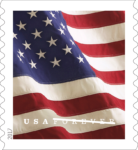 5158 (49¢) Flag coil stamp (Banknote printing), serpentine die cut 11 vert.
5158 (49¢) Flag coil stamp (Banknote printing), serpentine die cut 11 vert. 5170 (34¢) Pacific Calico Scallop shell coil stamp, serpentine die cut 9¾ vert.
5170 (34¢) Pacific Calico Scallop shell coil stamp, serpentine die cut 9¾ vert. Annual flower issue timed for spring and newlyweds OTTAWA Ð Once again, Canada Post will welcome spring and delight future newlyweds, gardeners and collectors with their annual spring flower issue. This year, the domestic-rate Permanent stamps will focus on two colourful varieties of daisies:
Annual flower issue timed for spring and newlyweds OTTAWA Ð Once again, Canada Post will welcome spring and delight future newlyweds, gardeners and collectors with their annual spring flower issue. This year, the domestic-rate Permanent stamps will focus on two colourful varieties of daisies: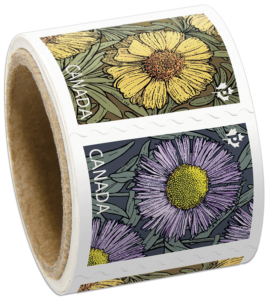 While named after a shoreline village in Ohio, the lakeside daisy is now almost exclusively found on southern Ontario’s Bruce Peninsula and Manitoulin Island. Designated “threatened” on both federal and provincial species-at-risk lists, the perennial plant thrives in development-prone areas of exposed bedrock with scant soil.
While named after a shoreline village in Ohio, the lakeside daisy is now almost exclusively found on southern Ontario’s Bruce Peninsula and Manitoulin Island. Designated “threatened” on both federal and provincial species-at-risk lists, the perennial plant thrives in development-prone areas of exposed bedrock with scant soil.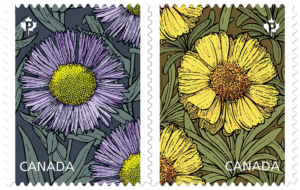 For 2017, all stamp issues will include references to Canada’s sesquicentennial. For the Daisies issue, the words “Canada 150” are printed on the stamps in microtype. Due to the popularity of this issue for wedding invitations and stationery, the 26 mm (W) X 32 mm (H) stamps are available in booklets of 10 or coils of 50 — with the coil liner printed with the lyrics of Harry Dacre’s 1892 classic song, “Daisy, Daisy.” A two-stamp Souvenir Sheet, prepaid postcards of both designs and strips of four and 10 stamps from the coil are also available. An Official First Day cover featuring both stamps is canceled in Tobermory, Ontario. The stamps were designed and illustrated by Debbie Adams, of Adams + Associates Design Consultants Inc. and printed by the Lowe-Martin Group.
For 2017, all stamp issues will include references to Canada’s sesquicentennial. For the Daisies issue, the words “Canada 150” are printed on the stamps in microtype. Due to the popularity of this issue for wedding invitations and stationery, the 26 mm (W) X 32 mm (H) stamps are available in booklets of 10 or coils of 50 — with the coil liner printed with the lyrics of Harry Dacre’s 1892 classic song, “Daisy, Daisy.” A two-stamp Souvenir Sheet, prepaid postcards of both designs and strips of four and 10 stamps from the coil are also available. An Official First Day cover featuring both stamps is canceled in Tobermory, Ontario. The stamps were designed and illustrated by Debbie Adams, of Adams + Associates Design Consultants Inc. and printed by the Lowe-Martin Group. 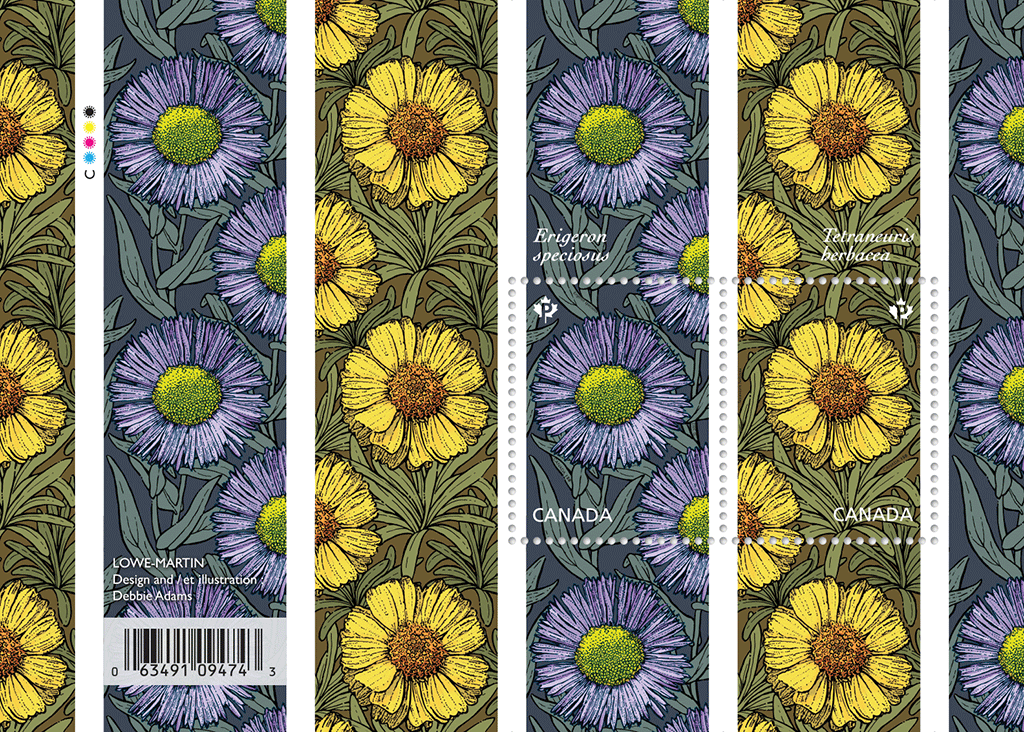 The souvenir sheet
The souvenir sheet 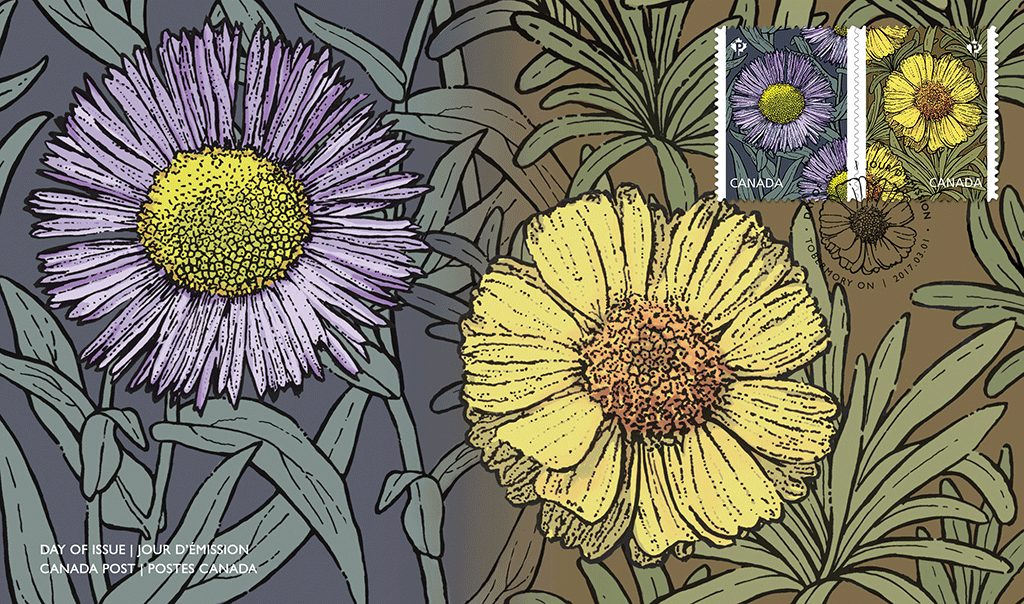 The Official First Day Cover
The Official First Day Cover

